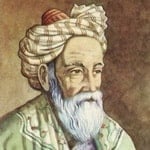Omar Khayyam (Ghiyāth ad-Dīn Abu'l-Fatḥ ʿUmar ibn Ibrāhīm al-Khayyam Nīshāpūrī)
 Omar Khayyam Neishāburi (full name: Ghyās Ad-Din Abu'l Fath Omar Ben Ebrahim Khayyam Neishāburi was born on 18 May 1048 in Neishābur who is also called Khayyāmi, Khayyām-e Neishāburi and Khayyāmi Al-Neishāburi. He was a philosopher, a scholar, a scholar, a mathematician, an astronomer and an Iranian composer of roba'yyāt (quatrains); Although his scientific training was superior to that of literature and although his appellation was "Hajje-al hagh" (pilgrim of truth), he owes fame above all to his world-famous quatrains. Khayyām's scientific acquisitions for humanity were numerous and very noteworthy; one of his most authoritative contributions can be considered to have ordered the calculations of the Iranian calendar. Those attributed to him in this area is still valid and has a greater focus on positions than the Christian calendar. He was a professor of mathematics, astronomy, literary, religious and historical sciences. his role in the solution of cubic equations and his studies on Euclid's fifth postulate have placed his name in scientific history as an authoritative mathematician. Khayyām has published numerous scientific and literary works in the following fields: mathematics, algebra, geometry, physics, music, astronomy, meteorology, theology, philosophy, poetry. But leaving all this aside, his greatest fame over the last two centuries in the world is due to his quatrains and has made his name count in the list of the four great poets of the world namely Homer, Shakspeare, Dante and Goethe. Among his scientific works we can mention some such as: the Treatises on algebra, on Euclid's postulates, on nature, on existence, on philosophy, on the difference between seasons and climates, on the customs and festivals of the Iranians, on the government etc ..
Omar Khayyam Neishāburi (full name: Ghyās Ad-Din Abu'l Fath Omar Ben Ebrahim Khayyam Neishāburi was born on 18 May 1048 in Neishābur who is also called Khayyāmi, Khayyām-e Neishāburi and Khayyāmi Al-Neishāburi. He was a philosopher, a scholar, a scholar, a mathematician, an astronomer and an Iranian composer of roba'yyāt (quatrains); Although his scientific training was superior to that of literature and although his appellation was "Hajje-al hagh" (pilgrim of truth), he owes fame above all to his world-famous quatrains. Khayyām's scientific acquisitions for humanity were numerous and very noteworthy; one of his most authoritative contributions can be considered to have ordered the calculations of the Iranian calendar. Those attributed to him in this area is still valid and has a greater focus on positions than the Christian calendar. He was a professor of mathematics, astronomy, literary, religious and historical sciences. his role in the solution of cubic equations and his studies on Euclid's fifth postulate have placed his name in scientific history as an authoritative mathematician. Khayyām has published numerous scientific and literary works in the following fields: mathematics, algebra, geometry, physics, music, astronomy, meteorology, theology, philosophy, poetry. But leaving all this aside, his greatest fame over the last two centuries in the world is due to his quatrains and has made his name count in the list of the four great poets of the world namely Homer, Shakspeare, Dante and Goethe. Among his scientific works we can mention some such as: the Treatises on algebra, on Euclid's postulates, on nature, on existence, on philosophy, on the difference between seasons and climates, on the customs and festivals of the Iranians, on the government etc ..
Omar Khayyām is known all over the world and his works have been translated into various languages. The English translation of his quatrains by Edward Fitzgerald, the French translation of the book on algebra and the French translation of the quatrains by the famous orientalist Garcin de Tassy are examples of his fame. They have also been translated and published in Italy.
Italian translations:
Omar Khayyam, Quartine, edited by Francesco Gabrieli, Newton Compton, Rome 1973
Omar Khayyam, Quartine (Roba'iyyat), edited by Alessandro Bausani, Einaudi, Turin 1956
Su Khayyām
Mario Chini (edited), Rubaiyat of Omar Khayyam according to the lesson of Edoardo Fitzgerald, Lanciano, Carabba 1919
Francesco Gabrieli (edited), Le Rubaiyyat of Omar Khayyàm, Florence, Sansoni, 1944 (recent reprints: Rome, Newton Compton).
Alessandro Bausani (edited), Quartine (Roba'iyyat), Turin, Einaudi 1956 (and further reprints)
A. Pagliaro-A. Bausani, Persian literature, Florence-Milan, Sansoni-Accademia, 1968
Carlo Saccone, The Sufi teacher and the beautiful Christian. Poetics of perversion in medieval Persia. Thematic history of classical Persian literature, vol. II, Rome, Carocci 2005
Places, squares, institutions, associations, universities, statues, etc. in Iran and around the world have his name. The bust of Khayyām can be admired in Bucharest, the capital of Romania, at the University of Oklahoma in America etc. In January 2009 in the courtyard of the United Nations office in Vienna a kind of pavilion in the shape of four arches was placed which is a combination of architectural styles, in which Achaemenid and Islamic decorations are visible and inside there are statues of four Iranian philosophers, Khayyām, Abu Rayhān Biruni, Zakariyā Rāzi and Abu Ali Sinā.
Also one of the "holes" of the moon (lunar depressions) in his honor was called "Omar Khayyām" and in the year 1980 an asteroid was always named after him (asteroid 3095). Khayyām, after an intense life, suddenly died on 4th December 1131 at his birthplace in Neishābur. The his mausoleum is located in this city within a garden.

